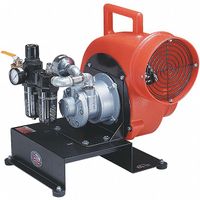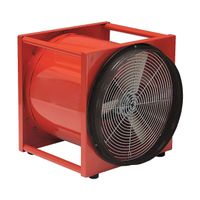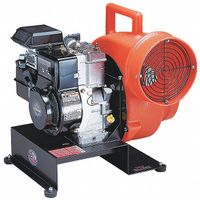Call +(254) 703 030 000 / 751 483 999 / 721 704 777
- Home
- Safety
- Confined Space
- Confined Space Fans Ventilation
.....Read More
Frequently Asked Questions
What is the purpose of using confined space fans and blowers?
Confined space fans and blowers are used to ensure the safety and health of workers operating in confined spaces. These areas, such as tanks, silos, tunnels, and manholes, often have limited ventilation, which can lead to the accumulation of hazardous gases, vapors, or dust. The primary purposes of using these fans and blowers include:
1. **Ventilation**: They provide fresh air to the confined space, diluting and displacing harmful contaminants. This helps maintain oxygen levels and reduces the concentration of toxic or flammable gases.
2. **Temperature Control**: By circulating air, these devices help regulate temperature, preventing heat stress and creating a more comfortable working environment.
3. **Removal of Contaminants**: Fans and blowers help remove airborne contaminants, such as dust, fumes, and vapors, which can pose respiratory hazards.
4. **Compliance with Regulations**: Many safety regulations and standards require adequate ventilation in confined spaces to protect workers. Using fans and blowers helps meet these legal requirements.
5. **Emergency Preparedness**: In case of an emergency, such as a gas leak, these devices can quickly clear the air, facilitating safe evacuation and rescue operations.
6. **Improved Visibility**: By reducing dust and fumes, fans and blowers can enhance visibility, allowing workers to perform tasks more safely and efficiently.
Overall, confined space fans and blowers are critical for maintaining a safe working environment, preventing accidents, and ensuring compliance with occupational safety standards.
How do air-powered fans and blowers work in confined spaces?
Air-powered fans and blowers operate in confined spaces by utilizing compressed air to generate airflow, which is crucial for ventilation, cooling, and removing hazardous gases or fumes. These devices are particularly useful in environments where electrical equipment might pose a risk due to explosive atmospheres or where electricity is not readily available.
The operation begins with compressed air being supplied to the fan or blower through a hose. This air is directed into a motor or turbine within the device. The compressed air expands and moves through the turbine, causing it to spin. This spinning action is transferred to the fan blades or impeller, which then creates airflow.
The design of the fan or blower determines the type of airflow produced. Axial fans, for example, move air parallel to the shaft of the fan, making them suitable for moving large volumes of air at low pressure. Centrifugal blowers, on the other hand, move air perpendicular to the intake, generating higher pressure and are ideal for applications requiring air to be moved through ductwork or over longer distances.
In confined spaces, these air-powered devices are essential for maintaining air quality and temperature. They help in diluting and displacing harmful gases, providing fresh air to workers, and preventing the buildup of heat. The absence of electrical components in air-powered fans and blowers reduces the risk of sparks, making them safe for use in potentially explosive environments.
Overall, air-powered fans and blowers are vital tools in confined spaces, ensuring safety and comfort by effectively managing airflow without the need for electrical power.
What are the safety considerations when using electric fans and blowers in confined spaces?
When using electric fans and blowers in confined spaces, several safety considerations must be addressed to ensure the safety of personnel and the effectiveness of ventilation:
1. **Explosion-Proof Equipment**: Use explosion-proof fans and blowers if there is a risk of flammable gases, vapors, or dust. This prevents ignition sources from causing explosions.
2. **Ventilation Adequacy**: Ensure the fan or blower provides sufficient airflow to dilute and remove hazardous substances. Calculate the required air changes per hour based on the size of the space and the nature of the contaminants.
3. **Electrical Safety**: Verify that all electrical components are properly insulated and grounded to prevent electrical shocks. Use equipment rated for the specific environment, especially in wet or damp conditions.
4. **Noise Levels**: Consider the noise generated by fans and blowers, as excessive noise can lead to hearing damage. Use hearing protection if necessary and choose quieter models if possible.
5. **Maintenance and Inspection**: Regularly inspect and maintain fans and blowers to ensure they are in good working condition. Check for wear and tear, and replace any damaged parts promptly.
6. **Proper Placement**: Position fans and blowers to optimize airflow and avoid creating dead zones where contaminants can accumulate. Ensure that the equipment does not obstruct exits or pathways.
7. **Training and Procedures**: Train personnel on the proper use and limitations of ventilation equipment. Establish emergency procedures in case of equipment failure or hazardous conditions.
8. **Monitoring**: Continuously monitor air quality to ensure that ventilation is effective. Use gas detectors to identify the presence of hazardous substances and adjust ventilation as needed.
9. **Compatibility with PPE**: Ensure that the use of fans and blowers does not interfere with personal protective equipment (PPE) and that PPE is suitable for the environment.
10. **Emergency Power**: Consider backup power sources to maintain ventilation in case of a power outage.
When should gasoline-powered blowers be used in confined spaces?
Gasoline-powered blowers should generally not be used in confined spaces due to the risk of carbon monoxide poisoning and the accumulation of other harmful exhaust gases. If their use is absolutely necessary, several precautions must be taken to ensure safety:
1. **Ventilation**: Ensure that the confined space is well-ventilated. This can be achieved by using additional ventilation equipment to introduce fresh air and expel exhaust gases.
2. **Monitoring**: Continuously monitor the air quality within the confined space for carbon monoxide and other hazardous gases using appropriate detection equipment.
3. **Duration**: Limit the time the blower is used within the confined space to minimize the buildup of exhaust gases.
4. **Personnel**: Only trained personnel should operate gasoline-powered blowers in confined spaces. They should be equipped with personal protective equipment (PPE), including respirators if necessary.
5. **Emergency Plan**: Have an emergency response plan in place, including immediate evacuation procedures and access to medical assistance in case of exposure to harmful gases.
6. **Alternatives**: Consider using electric or battery-powered blowers as safer alternatives, as they do not produce exhaust gases.
7. **Regulations**: Adhere to local regulations and guidelines regarding the use of gasoline-powered equipment in confined spaces.
By following these precautions, the risks associated with using gasoline-powered blowers in confined spaces can be mitigated, but it is always preferable to seek alternative methods or equipment that do not pose such hazards.
How do ducts and vents enhance the effectiveness of ventilation equipment in confined spaces?
Ducts and vents significantly enhance the effectiveness of ventilation equipment in confined spaces by facilitating the controlled movement of air, ensuring proper air exchange, and maintaining a safe and comfortable environment.
Firstly, ducts serve as conduits that direct the flow of fresh air into confined spaces and expel stale or contaminated air out. This targeted airflow is crucial in confined areas where natural ventilation is limited. By channeling air precisely where it is needed, ducts help in diluting and removing hazardous substances such as dust, fumes, and gases, thereby reducing the risk of respiratory issues and other health hazards.
Vents, on the other hand, act as exit points for the air being expelled. They are strategically placed to ensure that the air is effectively removed from the space, preventing the buildup of harmful substances. Proper vent placement is essential to create a continuous flow of air, which is necessary for maintaining air quality and temperature control.
Moreover, ducts and vents can be adjusted or designed to optimize airflow patterns, ensuring that all areas within the confined space receive adequate ventilation. This is particularly important in spaces with complex layouts or obstructions that could impede airflow.
Additionally, the use of ducts and vents can enhance the efficiency of ventilation equipment by reducing the energy required to move air. By minimizing resistance and optimizing airflow paths, these components help in achieving effective ventilation with less power consumption.
In summary, ducts and vents are integral to the functionality of ventilation systems in confined spaces, ensuring effective air distribution, contaminant removal, and energy efficiency, thereby enhancing overall safety and comfort.
What are the differences between air-powered, electric, and gasoline-powered ventilation systems?
Air-powered, electric, and gasoline-powered ventilation systems differ primarily in their power sources, operational efficiency, portability, and maintenance requirements.
**Air-Powered Ventilation Systems:**
- **Power Source:** Utilize compressed air, often from an external compressor.
- **Efficiency:** Generally less efficient in terms of airflow compared to electric and gasoline systems.
- **Portability:** Highly portable due to the absence of heavy motors; ideal for hazardous environments where electricity or gasoline use is risky.
- **Maintenance:** Low maintenance as they have fewer moving parts; however, they require a reliable air supply.
**Electric Ventilation Systems:**
- **Power Source:** Operate on electricity, either from a direct connection to the power grid or batteries.
- **Efficiency:** Offer consistent and efficient airflow; suitable for continuous operation.
- **Portability:** Corded models are less portable due to the need for a power outlet, while battery-operated models offer more flexibility.
- **Maintenance:** Require regular maintenance of electrical components; battery models need battery management.
**Gasoline-Powered Ventilation Systems:**
- **Power Source:** Run on gasoline engines.
- **Efficiency:** Provide high airflow and are powerful, making them suitable for large-scale operations.
- **Portability:** Highly portable and independent of external power sources, but heavier due to the engine and fuel.
- **Maintenance:** Require regular engine maintenance, including fuel management and engine servicing.
Each type of ventilation system is suited to specific environments and operational needs, with air-powered systems being ideal for explosive or flammable environments, electric systems for consistent and clean operations, and gasoline systems for high-power, remote applications.
How do you determine the appropriate size and type of fan or blower for a specific confined space?
To determine the appropriate size and type of fan or blower for a specific confined space, follow these steps:
1. **Assess the Space**: Measure the dimensions of the confined space to calculate its volume (length x width x height). This helps in determining the air changes per hour (ACH) required.
2. **Determine Air Changes Per Hour (ACH)**: Identify the required ACH based on the type of confined space and its use. General ventilation might require 6-12 ACH, while spaces with hazardous fumes may need 20-30 ACH or more.
3. **Calculate Required Airflow**: Multiply the volume of the space by the desired ACH to get the required airflow in cubic feet per minute (CFM). For example, a 1,000 cubic foot space needing 10 ACH requires 10,000 cubic feet of air per hour, or approximately 167 CFM.
4. **Select Fan or Blower Type**: Choose between axial fans, which are suitable for moving large volumes of air at low pressure, and centrifugal blowers, which are better for high-pressure applications. Consider the nature of the air (clean, dusty, or containing hazardous substances) to select materials and design features that ensure safety and efficiency.
5. **Consider Environmental Factors**: Evaluate temperature, humidity, and potential exposure to corrosive or explosive substances. This influences the choice of materials and motor type (e.g., explosion-proof motors for hazardous environments).
6. **Check Noise Levels**: Ensure the fan or blower operates within acceptable noise levels for the environment to prevent hearing damage or discomfort.
7. **Review Power Supply and Installation**: Ensure compatibility with available power sources and assess installation constraints, such as space for mounting and ducting requirements.
8. **Consult Regulations and Standards**: Adhere to relevant safety standards and regulations, such as OSHA or NFPA guidelines, to ensure compliance and safety.
By following these steps, you can select a fan or blower that effectively ventilates the confined space while meeting safety and operational requirements.



